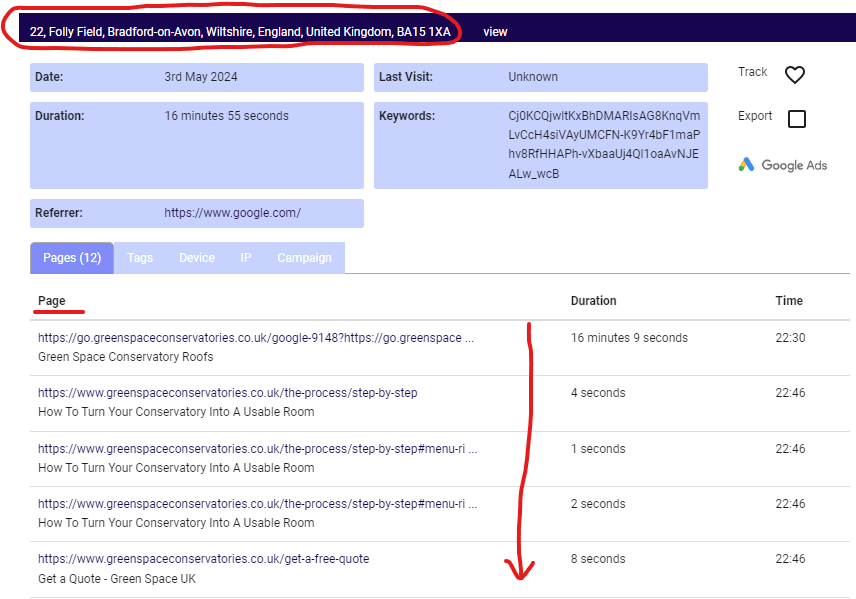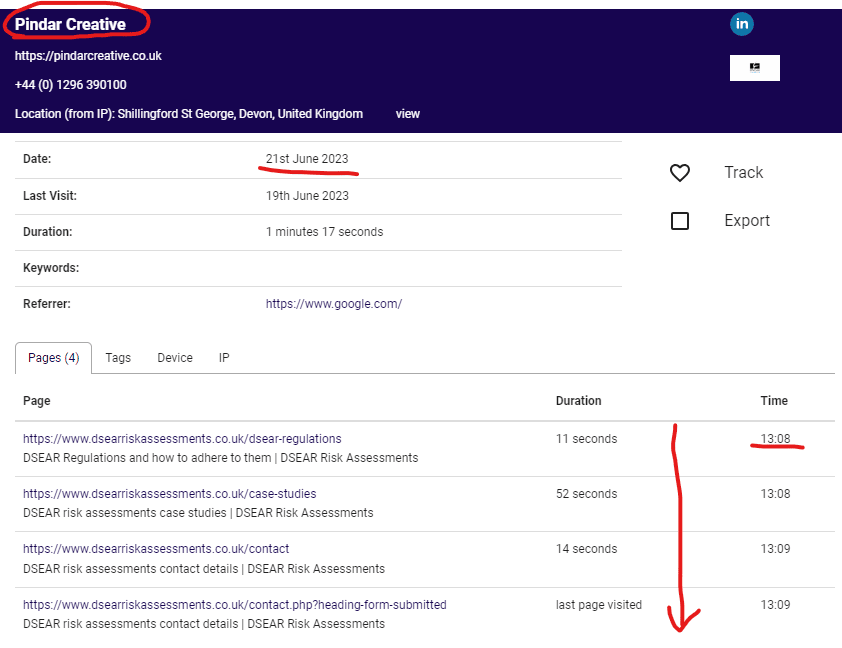Who is Visiting My Website?
You can’t identify people who are ‘cold’ to your website and haven’t willingly shared details with you. But you can still identify their home address or business name in many cases.
Bad news and good news about who is visiting your website
Bad news
You can’t (legally) identify the individual person who visited your website.
You can’t see their name, email, or anything else.
The caveat here is that in some places (e.g. the USA) there is a more liberal approach to private data but such approaches wouldn’t be allowed in Europe.
Good news
You can identify some of your visitors (roughly 10-30% of the time) as being from:
- Home addresses
- Businesses
- Other geolocated locations where the person was when they went to your website
But you still won’t know the name of the specific person who visited.
So how is that useful?
Being able to identify only a home or business is not perfect, but it does enable you to get a competitive edge over others who won’t even know such technology exists.
What you CAN identify about who is visiting your website
Advancements in technology have revolutionised the ability to get more insights from website traffic.
By using geolocation software and IP address tracking, you can identify the origins of some of your website visitors, transforming anonymous data into actionable intelligence in these ways …
Technology to identify website visitors
Sophisticated software can analyse traffic to websites and determine whether it comes from residential ISPs, company networks, or has been geolocated in other ways. This technology can often (10-30% of the time) pinpoint the actual building from which the traffic originates, especially when users consent to location tracking.
In the world of B2C, where it’s useful to know which home addresses visited a website (but not the name of the person), just being aware that someone at that location is interested in what you offer means that you have the opportunity to reach out to that address.
Here’s an example of someone (who consented to being tracked) from an identifiable home address and what they looked at on the website page by page:

Find out more about how to see the home addresses of people visiting your website.
In the world of B2B, many companies would like to know which other companies have been to their website. This is typically identifiable by IP address and doesn’t require any consent to be tracked.
Here’s an example of someone from a business that has been to the website of another business, including what they looked at page by page:

Find out more about how to see the companies that visited your website.
Getting consent to identify website visitors
If you sell B2B then you don’t need consent to identify the name of the business that went to your website.
If you want to know the geolocation of a website visitor (this would normally be someone in their home) then you need a clear, unambiguous pop-up that ensures that visitors are well informed before their data is processed. That pop-up explains that their location data is being requested and provides them with the option to opt-in or opt-out.
Doing what your competitors aren’t
Although only 10-30% of visitors (B2C or B2B) can be precisely identified in this way, this information is incredibly valuable because it allows you to reach out to homes or businesses where interest is already established.
You know that someone at that residential or business location has been to your website so it makes sense to follow that up in a range of ways.
What to do with what you know about who is visiting your website
You don’t know the name of the person who came to your website.
But you can identify a percentage of visitors by:
- Home address
- Company name
10-30% is the typical range, although it can vary depending on the visibility of the business and types of website traffic attracted in.
Here are two summaries (focusing on B2C and B2B) of what to do with that knowledge of visitors to your website.
B2C (you sell to consumers, identifiable at their home address)
This is just a summary of a more detailed article I wrote about how to follow up on residential visitors to your website …
- Cherry pick the home locations of most interest to you.
- Post quality materials (e.g. a nice brochure) addressed to ‘The Householder’ and explain that you are introducing your business to homes in the area. Don’t tell people you identified their website visit, as that can creep people out!
- Ensure your mailout has a call to action (e.g. quoting a discount code) that you can link to new enquiries you get. This ensures that you can prove that this method of proactive marketing achieves a strong return on investment.
B2B (you sell to businesses, identifiable at their business location)
This is just a summary of a more detailed article I wrote about how to follow up on companies that visit your website …
- Use LinkedIn to find people at that business who may be a close match to who you would sell to. They may not have been the original website visitor, but could be close to them.
- Reach out to them via LinkedIn (or email – it’s easy to get business emails for people at no cost – contact me if you want to know how), explaining that you saw someone from their business had been to your website and asking if you can help, or if they can pass your details onto someone else in their business (that would be interested in what you offer).
- If you get no response then follow up with something printed in the mail, addressed to each person, encouraging them to have dialogue.
- You may also like to do follow up phone calls.
GDPR and privacy related to who visits your website
GDPR focuses on personally identifiable data, which I cover from two perspectives here …
Identifying business visitors to your website
Identifying a business name that visited your website is not personally identifiable data. If it was, then all the companies tracking software providers would not be allowed to operate.
If you identify someone at that business, reach out to them, and they take offence in some way, or feel their privacy has been invaded, then you haven’t broken GDPR regulations because you didn’t originally identify that person via the companies identification software. In fact, you probably found them via LinkedIn and took an educated guess that they may be the right person to contact.
Identifying home visitors to your website
Provided that you’ve ensured that people have to opt in to have their location tracked (which 10-30% of website visitors do allow via pop-up boxes that appear when they go to websites), you can market your services or products to that home address.
You won’t know the individual person at that address and so don’t have any personally identifiable information. All you can do is address something (e.g. a brochure) to ‘The Householder’ (or similar) and hope that the person who picks up the mail was your original website visitor or passes it onto the person who was.
You would likely only send to an address once and people have the choice to interact or not.
Obviously, if you included reference to the fact you identified someone from that address went to your website then that could come across in the wrong way – no-one wants to feel they’ve been targeted. But if you make it appear that several people in their area have received the same printed materials then they will think it’s a coincidence that you sent their home something after they’d been to your website.
Summarising what you can’t or can know about who is visiting your website
- You won’t know the name of the person who visited.
- You could identify (10-30% of the time) the home (or other) geographic location or the business name of the person who visited your website.
- By taking action on such information you can beat your competitors (including other websites that your prospect customers may have visited) by reaching out to them after becoming aware of their visit to you.